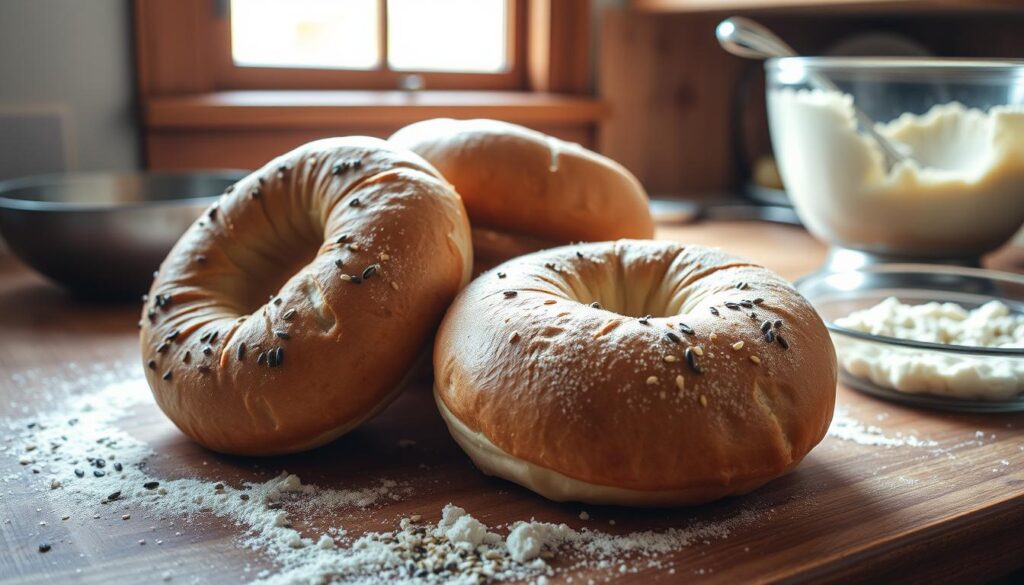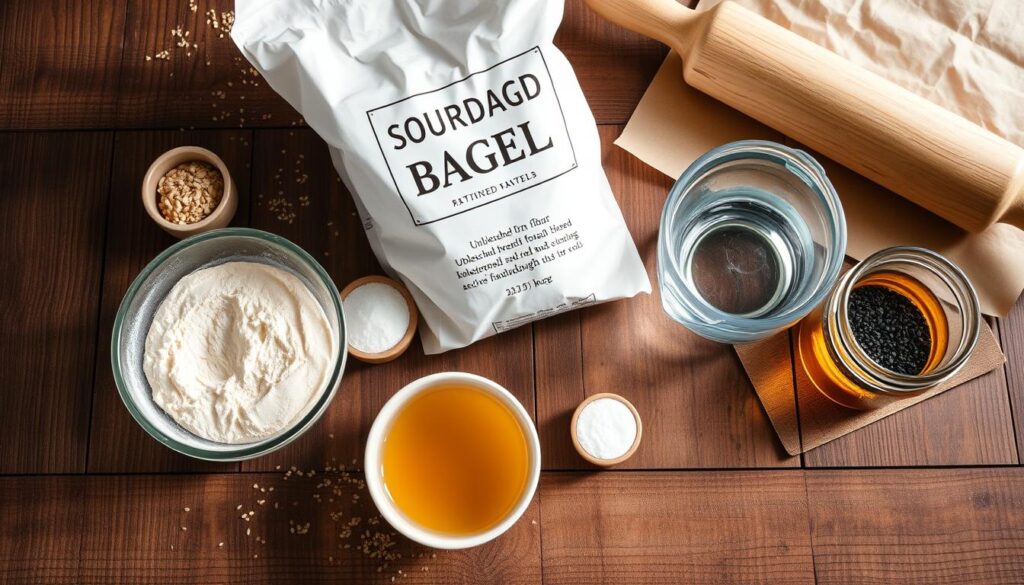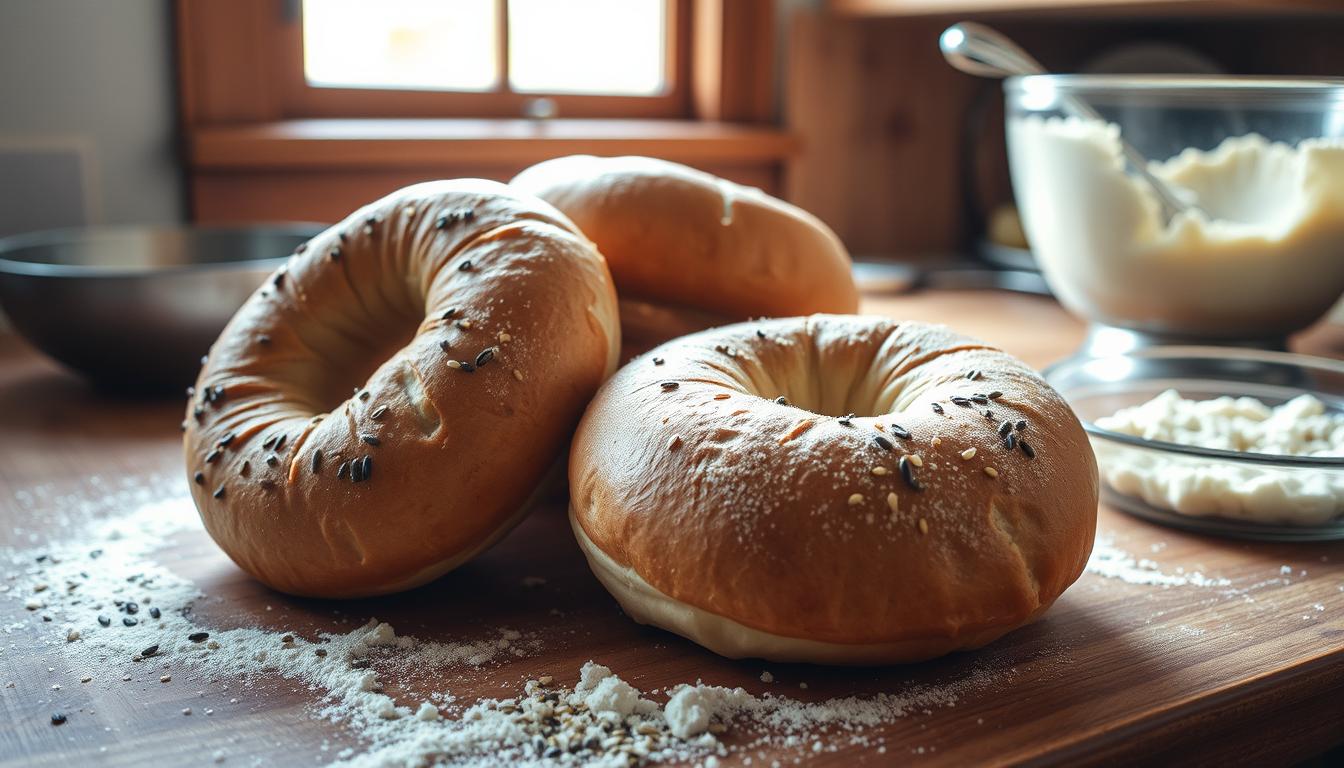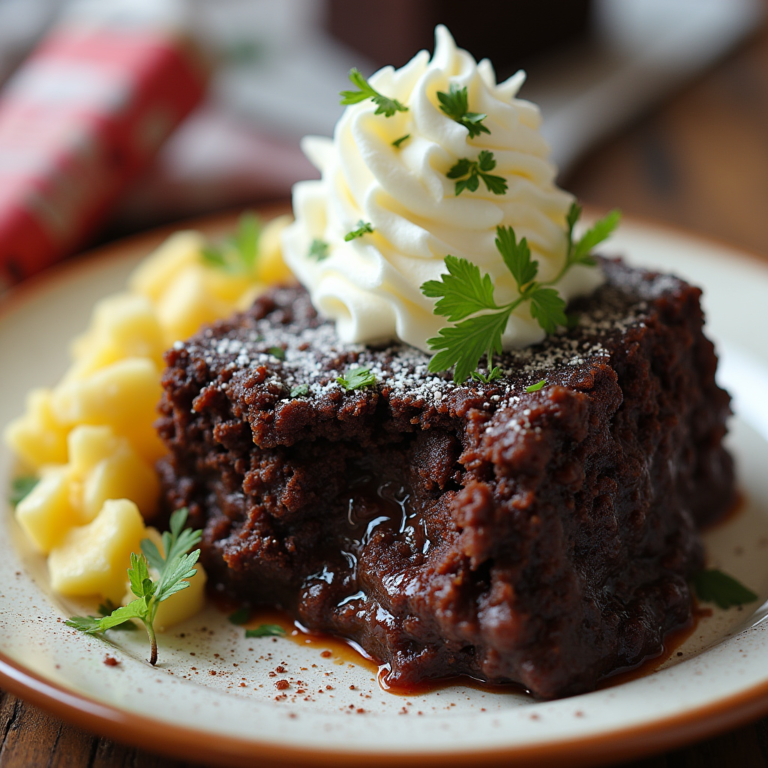Delicious Sourdough Bagel Recipe
Delicious Sourdough Bagel Recipe Imagine waking up to the smell of freshly baked sourdough bagels. Their chewy texture and tangy flavor make a great start to your day. Making these in your kitchen beats buying them from a store.
In this guide, you’ll learn how to make your own Delicious Sourdough Bagel Recipe. They’ll taste like they came from a New York bakery.

A close-up of freshly baked sourdough bagels, showcasing their gol
Key Takeaways
- Learn the unique benefits of using a sourdough starter for making chewy, flavorful bagels
- Understand the essential ingredients and equipment needed to bake professional-quality sourdough bagels at home
- Discover the step-by-step process for mixing, kneading, shaping, proofing, and baking the perfect sourdough bagels
- Explore a variety of topping and flavor options to customize your bagels
- Pick up tips for maintaining your sourdough starter and ensuring long-lasting freshness
Why Sourdough Makes the Best Bagels
Delicious Sourdough Bagel Recipe is the top choice for making perfect bagels. Its unique fermentation process improves the texture and flavor. This can’t be matched by commercial yeast.
The Science Behind Sourdough Fermentation
Sourdough uses wild yeast and lactobacillus bacteria for leavening. This slow fermentation makes the dough chewy and elastic. It also adds a tangy, complex flavor.
Unlike yeast, sourdough’s mix of wild yeast and bacteria creates a rich taste. It’s like a symphony of flavors.
Benefits of Natural Leavening
- Longer shelf life: Sourdough bread lasts longer than yeast-made bread.
- Improved digestibility: Fermentation breaks down gluten, making it easier to digest.
- Enhanced nutritional value: Sourdough has more vitamins, minerals, and antioxidants than yeast bread.
Flavor Development Process
During fermentation, wild yeast and bacteria create many aromatic compounds. This makes the bread complex and nuanced. The flavor can be tangy, sour, sweet, or nutty.

“Sourdough bread is a true labor of love, but the results are well worth the effort. The unique flavors and texture it imparts on a bagel are simply unparalleled.”
Essential Ingredients for Sourdough Bagel Recipe
Making the perfect sourdough bagel needs the right ingredients. The bread starter is key, giving the dough its unique taste and texture. Other important ingredients also come together to make the ultimate sourdough bagel.
Choosing the right flour is crucial. Use a mix of high-protein bread flour and whole wheat or rye flour. This mix makes the bagels chewy and full of sourdough flavor.
Salt is also vital for flavor. Use high-quality sea salt or kosher salt. It balances the dough’s sweetness and brings out the other flavors.
A healthy, active sourdough starter is essential. It gives the bagels their natural rise and complex taste. Make sure to keep your starter fed and active before mixing the dough.
| Ingredient | Quantity | Purpose |
|---|---|---|
| Bread Flour | 3 cups | Provides structure and chewiness |
| Whole Wheat Flour | 1 cup | Adds nutty, earthy flavors |
| Sourdough Starter | 1 cup | Leavens the dough and contributes complex flavors |
| Salt | 1 1/2 teaspoons | Enhances overall flavor and balance |
| Water | 1 1/4 cups | Hydrates the dough and activates the gluten |
With these ingredients, you’re ready to make delicious sourdough bagels. They’ll impress anyone who loves artisan baking.

Equipment You’ll Need for Bagel Making
To make homemade bagels, you need some key tools. These tools help you bake bagels that are chewy and taste like they came from a bakery. Having the right equipment makes a big difference.
Must-Have Tools
- A sturdy mixing bowl for kneading the dough
- A dough scraper or bench knife to aid in shaping the bagel rounds
- A large pot or Dutch oven for boiling the bagels before baking
- A baking sheet or stone for the final bake
- A sharp knife or bread lame for scoring the bagels
Optional but Helpful Equipment
These tools are not essential but can make bagel making easier and better:
- A stand mixer with a dough hook attachment to knead the dough
- A digital kitchen scale to ensure precise ingredient measurements
- A proofing basket or couche to support the shaped bagels during the final rise
- A spray bottle for misting the bagels during baking to achieve a shiny crust
Baking Surface Options
For the final bake, you can use a baking sheet, a pizza stone, or a baking steel. A pizza stone or baking steel can make your bagels taste like they were baked in a professional oven. Make sure to preheat your chosen surface well to get a crispy crust on your homemade bagels.
| Baking Surface | Advantages | Considerations |
|---|---|---|
| Baking Sheet | Widely available, easy to use | May not produce as even a rise or crust as other options |
| Pizza Stone/Baking Steel | Replicates commercial bagel oven, promotes even cooking | Requires preheating for best results, more expensive investment |
With the right tools, you can become a pro at bagel baking. You’ll be able to make delicious homemade bagels in your kitchen.
Maintaining Your Sourdough Starter
A healthy bread starter is key to baking tasty sourdough bread. It makes your bagels rise well and gives them a tangy taste. Here are some tips to keep your starter in top shape.
Feeding Schedule
Feed your starter twice a day, 12 hours apart. Use equal parts flour and water, like 50g each. Stir well to mix air and avoid a thick mix.
Storage Essentials
- Keep your starter in a clean, airtight container at room temperature.
- Use a breathable cloth or coffee filter to cover it. This lets gases out.
- Don’t store it in the fridge. It can slow down your starter.
Troubleshooting Tips
If your starter is slow or smells bad, try these:
- Discard and refresh with fresh flour and water.
- Feed it 3-4 times a day.
- Try different flours or water amounts.
With practice, you’ll get good at keeping a lively sourdough bread starter. Regular care is crucial for making great bagels.
“The secret to great sourdough is a healthy, active starter. Treat it with care, and it will reward you with incredible flavor.”
Step-by-Step Mixing and Kneading Process
Learning to make sourdough bagels starts with mixing and kneading. Getting the dough just right is key for that chewy texture. Let’s explore the steps to make your sourdough bagel recipe perfect.
Proper Dough Consistency
The dough should feel slightly tacky but not too sticky. It should keep its shape when you squeeze it gently. You might need to add more flour or water while kneading to get it right.
Window Pane Test Guide
The window pane test checks if your dough is kneaded enough. Stretch a small dough piece between your fingers. If it stretches thin enough to see light through without tearing, it’s ready. This means your dough proofing will likely succeed.
Bulk Fermentation Tips
- Let the dough ferment slowly for the best flavor and texture.
- Watch it grow, aiming for it to double in size before shaping.
- Keep the temperature between 75-80°F for the best results.
Follow these tips, and you’re on your way to making perfect sourdough bagels at home. Stay tuned for the next steps in making these delicious treats!
Shaping Perfect Bagel Rings
Making homemade bagels is a fun and rewarding task. Shaping the dough into perfect rings is key. It takes a bit of practice, but with the right techniques, you can make beautiful authentic bagel recipe rings every time.
Start by dividing your dough into equal parts, about 4-5 ounces each. To shape the bagels, follow these simple steps:
- Roll each piece of dough into a smooth ball.
- Use your index finger to poke a hole through the center of the ball, then gently stretch and rotate the dough to create a consistent ring shape.
- Avoid over-handling the dough, as this can cause the bagel to lose its shape.
- Gently pinch the seam closed, ensuring a seamless ring.
- Maintain a consistent size and shape by using a round cookie cutter or bagel maker as a guide.
One key tip for shaping perfect homemade bagels is to work with chilled dough. This helps the bagels keep their shape during boiling and baking. Also, use a light touch and avoid too much handling to keep the bagel hole well-defined.
“The secret to a perfectly shaped authentic bagel recipe lies in the simplicity of the shaping technique.”
With a bit of practice and focus on detail, you’ll soon be able to make beautifully shaped homemade bagels. They’ll not only look great but also have that signature chewy texture.
The Art of Proofing Sourdough Bagels
Proofing is key in making sourdough bagels. It lets the dough ferment, creating a chewy texture and complex flavors. Getting proofing right is crucial for perfect sourdough bagels.
Temperature and Timing Guidelines
The best proofing temperature is between 70°F and 85°F (21°C to 29°C). This range helps the dough rise slowly and evenly. Proofing time varies based on starter strength, room temperature, and dough hydration. But usually, it takes 8 to 12 hours for the perfect rise.
Visual Cues for Perfect Proofing
Knowing when your bagels are ready is easy. Look for them to grow bigger and feel slightly jiggly. The dough’s surface should be smooth and shiny. A gentle poke should make it spring back, showing it’s fermented well.
By following these guidelines and watching for these signs, you can make sure your sourdough bagels are ready for baking.
Boiling and Bath Additions
To get the perfect chewy texture and authentic flavor in your bagel baking, you need to boil them first. This step is key for a great crust and adding amazing flavors to your authentic bagel recipe.
It’s a simple yet important step. First, shape your dough into perfect rings. Then, gently lower them into boiling water. This boiling stage does several things:
- It sets the exterior, making it chewy.
- It gives a shiny, appealing look.
- It helps the dough keep its shape while baking.
But there’s more. You can add different things to the water bath to enhance your bagels:
- Honey or Malt Syrup: These sweeteners add a caramelized flavor and a golden-brown crust.
- Baking Soda: A little baking soda makes the water more alkaline. This results in a richer color and chewier texture.
- Salt: Salt adds to the flavor, balancing the sweetness and enhancing the dough’s taste.
Mastering boiling and bath additions will help you make bagels that look great and taste amazing. You’ll impress everyone with your homemade bagel baking skills!
Bagel Toppings and Variations
Take your artisan baking to the next level by trying different bagel toppings and variations. While classic homemade bagels are tasty, adding unique toppings can make them even better.
Classic Topping Combinations
For those who love tradition, here are some classic bagel toppings:
- Sesame seeds
- Poppy seeds
- Everything seasoning (a mix of sesame seeds, poppy seeds, garlic, onion, and salt)
- Plain with cream cheese
- Lox (smoked salmon) and cream cheese
Creative Flavor Options
Want to try something new? Here are some creative artisan baking ideas:
- Asiago or cheddar cheese bagels
- Sundried tomato and basil bagels
- Cinnamon raisin bagels
- Blueberry or cranberry bagels
- Jalapeno cheddar bagels
When adding toppings, brush the homemade bagels with water or egg wash. This helps the toppings stick and adds flavor and looks to each bite.
“Experimenting with unique artisan baking flavors is the key to elevating your homemade bagels to the next level.”
Baking Techniques for Chewy Texture
Getting the perfect chewy texture in your homemade sourdough bagels is all about mastering the baking process. The oven temperature, timing, and steam all play key roles. Each step is crucial for that irresistible, bagel-shop-worthy bite.
First, preheat your oven to a scorching 450°F (232°C). This high heat is key for a golden-brown crust and a soft, chewy interior. As the bagels bake, create a steamy environment by placing a shallow baking pan filled with hot water on the bottom rack of the oven.
The steam helps gelatinize the bagels’ exterior, locking in moisture for that signature chew. Bake the bagels for 12-15 minutes, rotating the pan halfway through. This ensures they’re beautifully bronzed.
To ensure even baking and a consistent texture, keep a close eye on the bagels during the final minutes. Test for doneness by gently pressing on the top of a bagel. It should feel set and slightly firm, but still have a slight give.
“The key to achieving that perfect bagel texture is all about striking the right balance between a crisp crust and a soft, chewy interior.”
After baking, let the bagels cool on a wire rack for at least 15 minutes before slicing and serving. This resting period allows the interior to fully set. It results in that classic bagel baking experience you crave.
By mastering these sourdough bagel recipe baking techniques, you’ll consistently produce homemade bagels with an irresistible chewy texture. They’ll rival your favorite bakery.
Storage and Freshness Tips
Keeping your homemade sourdough bagels fresh is key to enjoying their taste and texture. Store them in an airtight container at room temperature for up to 3 days. If you want to keep them longer, freeze them for up to 2 months. Wrap them in plastic wrap or put them in a freezer-safe bag for easy thawing.
When your bagels get stale, there’s a fix. Just reheat them in a 350°F oven for 5-7 minutes. This will make them soft and crispy again. Or, you can cube them for a tasty bread pudding or stuffing.
With these tips, you can enjoy your sourdough bagels for days. Every bite will be as tasty as the first.
FAQ
How long does it take to make sourdough bagels?
Making sourdough bagels takes about 12-24 hours. This includes fermentation, shaping, boiling, and baking. But, you only need to actively work for a few hours. The rest of the time is for proofing and fermentation.
Can I use a store-bought sourdough starter for this recipe?
Yes, you can! A store-bought starter works just as well. Just make sure it’s active and healthy. It should rise well and bubble when fed.
Do I need any special equipment to make sourdough bagels?
You can make sourdough bagels with basic tools. But, some equipment makes it easier. You’ll need a baking sheet, parchment paper, a large pot, and a pizza stone or baking steel for best results.
How do I know when my sourdough bagels are fully proofed and ready to bake?
Check if your bagels have doubled in size and pass the “float test.” To do the float test, gently drop a bagel into water. If it floats, it’s ready to bake.
Can I freeze sourdough bagels?
Yes, you can freeze them. Cool the bagels completely, then put them in an airtight container or bag. Freeze for up to 3 months. To reheat, thaw at room temperature and then toast or warm in the oven.
What’s the best way to get a chewy texture in my sourdough bagels?
For a chewy texture, boil the bagels before baking. This step makes the outside chewy. Baking at 450°F also helps. It makes the crust crisp while keeping the inside soft.
Can I add mix-ins or toppings to my sourdough bagels?
Absolutely! Sourdough bagels are great for mix-ins and toppings. Try sesame seeds, everything seasoning, cheddar cheese, garlic, onions, or sweet toppings like cinnamon-sugar. Add them after boiling for best results.







